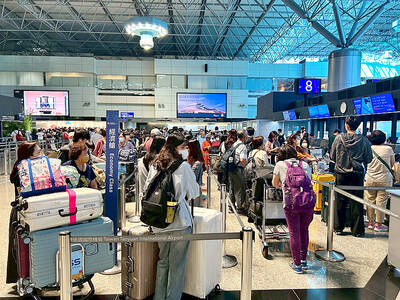A research team at the National Health Research Institutes (NHRI) yesterday said more than half of older people experience obstructive sleep apnea (OSA), but not all of them develop symptoms of loud snoring.
The NHRI research team led by Cheng Wan-ju (鄭婉汝), an associate investigator at NHRI’s National Center for Geriatrics and Welfare, cooperated with researchers from Iceland’s Nox Research, Harvard Medical School’s Brigham and Women’s Hospital and China Medical University’s Sleep Medicine Center in Taichung, analyzing the symptom profiles and endotypes (a subtype of a disease condition, defined by a distinct pathophysiological mechanism) of OSA.
Cheng yesterday said the overall prevalence of OSA in the population is about 15 percent, but in people aged 60 years or older, it could be as high as 70 percent in men and 56 percent in women.

The common symptoms of OSA include snoring, memory loss, insomnia and awakening in the morning with a dry mouth or sore throat, she said, adding that long-term OSA has been associated with cardiovascular disease, cerebrovascular disease, impaired cognitive functioning and excessive daytime sleepiness.
Cheng’s research team analyzed 509 patients with moderate to severe OSA from a single sleep center for endotypic traits, and they identified three endotype clusters among patients in Taiwan — high collapsibility (upper airway collapse) and loop gain (unstable ventilatory control), low arousal threshold (awaken easily) and low compensation (poor upper airway muscle effectiveness).
People with OSA caused by upper airway collapse or unstable ventilatory control are more associated with excessively sleepy symptoms, those with low arousal threshold are associated with disturbed sleep symptoms, and those with poor upper airway muscle effectiveness exhibit fewer symptoms, she said.
Cheng said most cases of older people with OSA are due to unstable ventilatory control and poor upper airway muscle effectiveness, and many of them are asymptomatic or suffer from insomnia, so without exhibiting the common symptoms of loud snoring or daytime sleepiness, sometimes their OSA condition is overlooked.
As OSA is usually diagnosed through polysomnography, a sleep study that requires that the patient sleep overnight with monitoring devices in a sleep center, and while the common treatment for OSA is wearing a continuous positive airway pressure device, patient compliance is relatively low, she said.
Cheng said that having identified the different endotypic clusters, the treatment method could be better customized for each patient’s condition, such as prescribing upper airway surgery or medication.
As many older people with OSA do not have symptoms of loud snoring or daytime sleepiness, they should go to see a doctor for examination if they feel “unable to sleep well” or if their family or friends notice they are suffering from impaired cognitive functioning and increased blood pressure, and should not just neglect it or take sleeping pills on their own, Cheng said.
The team’s findings were published in medical journals Annals of the American Thoracic Society in June last year, and the European Respiratory Journal last month, the NHRI said.

Three batches of banana sauce imported from the Philippines were intercepted at the border after they were found to contain the banned industrial dye Orange G, the Food and Drug Administration (FDA) said yesterday. From today through Sept. 2 next year, all seasoning sauces from the Philippines are to be subject to the FDA’s strictest border inspection, meaning 100 percent testing for illegal dyes before entry is allowed, it said in a statement. Orange G is an industrial coloring agent that is not permitted for food use in Taiwan or internationally, said Cheng Wei-chih (鄭維智), head of the FDA’s Northern Center for

The Chinese military has built landing bridge ships designed to expand its amphibious options for a potential assault on Taiwan, but their combat effectiveness is limited due to their high vulnerability, a defense expert said in an analysis published on Monday. Shen Ming-shih (沈明室), a research fellow at the Institute for National Defense and Security Research, said that the deployment of such vessels as part of the Chinese People’s Liberation Army (PLA) Navy’s East Sea Fleet signals a strong focus on Taiwan. However, the ships are highly vulnerable to precision strikes, which means they could be destroyed before they achieve their intended

LOOKING NORTH: The base would enhance the military’s awareness of activities in the Bashi Channel, which China Coast Guard ships have been frequenting, an expert said The Philippine Navy on Thursday last week inaugurated a forward operating base in the country’s northern most province of Batanes, which at 185km from Taiwan would be strategically important in a military conflict in the Taiwan Strait. The Philippine Daily Inquirer quoted Northern Luzon Command Commander Lieutenant General Fernyl Buca as saying that the base in Mahatao would bolster the country’s northern defenses and response capabilities. The base is also a response to the “irregular presence this month of armed” of China Coast Guard vessels frequenting the Bashi Channel in the Luzon Strait just south of Taiwan, the paper reported, citing a

About 4.2 million tourist arrivals were recorded in the first half of this year, a 10 percent increase from the same period last year, the Tourism Administration said yesterday. The growth continues to be consistent, with the fourth quarter of this year expected to be the peak in Taiwan, the agency said, adding that it plans to promote Taiwan overseas via partnerships and major events. From January to June, 9.14 million international departures were recorded from Taiwan, an 11 percent increase from the same period last year, with 3.3 million headed for Japan, 1.52 million for China and 832,962 to South Korea,